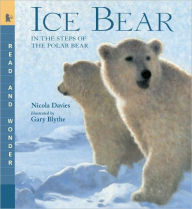Polar Bears
by Gail Gibbons, Gail Gibbons (Illustrator), Megan Lloyd (Illustrator)
Paperback
(Illustrate)
$7.99
- ISBN-13: 9780823417681
- Publisher: Holiday House
- Publication date: 07/01/2002
- Edition description: Illustrate
- Pages: 32
- Product dimensions: 9.80(w) x 9.50(h) x 0.10(d)
- Lexile: 700L (what's this?)
- Age Range: 5 - 8 Years
Eligible for FREE SHIPPING details
.
7.99
Out Of Stock
Customers Who Bought This Item Also Bought
-
- Wolves
- by Gail Gibbons
-
- Penguins!
- by Gail GibbonsGail Gibbons
-
- Reindeer
- by Katie Marsico
-
- About Birds: A Guide for…
- by Cathryn SillJohn Sill
-
- Beaks!
- by Sneed B. CollardRobin Brickman
-
- Where Does a Polar Bear Live? …
- by Sarah L. ThomsonJason Chin
-
- What Do You Do When Something…
- by Steve JenkinsSteve Jenkins
-
- Energy Island: How one…
- by Allan DrummondAllan Drummond
-
- Feathers: Not Just for Flying
- by Melissa StewartSarah S. Brannen
-
- Ice Bear: In the Steps of the…
- by Nicola DaviesGary Blythe
-
- Penguins
- by Seymour Simon
-
- Frogs and Toads
- by Bobbie KalmanTammy Everts
Recently Viewed
Children's Literature
Information about the polar bear is detailed and complete enough to answer most questions younger readers would have about this variously called "sea bear" by scientists and "Nanook" by native people. As with other books in the series, Gibbons uses diagrams, explains how and why a certain feature exists (polar bears have no eyelashes, for instance, because they would collect ice), maps and labels to good advantage. While Gibbons varies page design for visual interest, there is no denying that the pen and ink illustrations tinted in icy blue, white and green create a monotonous sameness for the reader and often seem hastily done or strangely proportioned. Still, as straightforward information, this text does the job, and a last page includes extra information. Sandra Markle's Growing Up Wild: Bears (Atheneum, 2000) has more visual appeal and a more flowing text but doesn't include as much information about the polar bear as does this useful if not especially elegant book. 2001, Holiday House, $16.95. Ages 6 to 10. Reviewer: Susan Hepler
School Library Journal
Gr 1-4-This charmingly illustrated book is full of facts about this Arctic animal: where it lives, what it eats, how it gets its food, when it mates, how it rears its young, and the dangers it faces. Temperatures are given in Fahrenheit and Celsius, weight in pounds and kilograms, height in feet and meters. Although lots of information is imparted, some readers may be left with questions. For example, the text states that a polar bear "is able to catch a seal about every five days." Does this mean it only feeds every five days? Despite minor flaws, this book will be a useful introduction to these magnificent animals, and readers will be enticed by the appealing illustrations, many of which are labeled.-Edith Ching, St. Albans School, Mt. St. Alban, Washington, DC Copyright 2001 Cahners Business Information.
Kirkus Reviews
Largest of the bears, the familiar white polar bear inhabits the ice and waters of the Arctic Circle catching seals, caribou, seabirds, and when meat cannot be found, berries, mushrooms, and seaweed. Gibbons describes how polar bears are adapted to the harsh climate where temperatures can fall to minus-30 degrees Fahrenheit, explaining how the white guard hairs trap warm air near the bear's body, the black skin absorbs sunlight, and a thick layer of fat keeps the bear warm. Handsome watercolor paintings show big and baby bears hunting, eating, swimming, and sleeping. She is especially facile at capturing the many shades of white in the bear's fur, and the blue white texture of the ice flows. Gibbons also captures the dignity of the bears, almost hunted to extinction in the 1970s and now making a comeback in the wild, while including the details children so enjoy. For example, a bear can eat 150 pounds of seal at one meal, but only eats the blubber and skin. She concludes with a warning about pollution and other dangers for polar bears, and brief bear facts. Another fine science title by a prolific author of books for young readers. (Nonfiction. 6-9)












